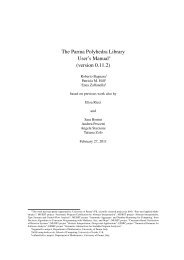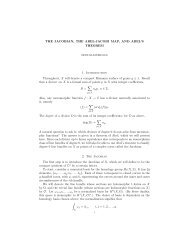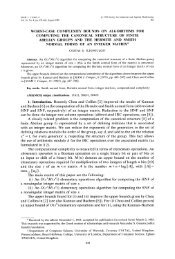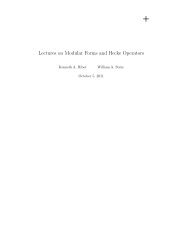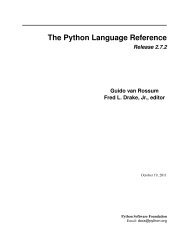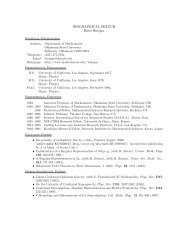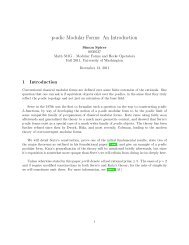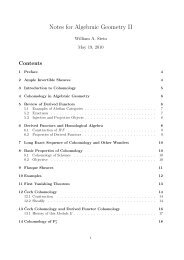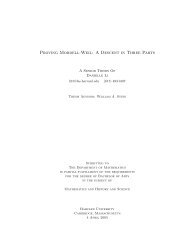Efficient implementation of the Hardy-Ramanujan ... - William Stein
Efficient implementation of the Hardy-Ramanujan ... - William Stein
Efficient implementation of the Hardy-Ramanujan ... - William Stein
Create successful ePaper yourself
Turn your PDF publications into a flip-book with our unique Google optimized e-Paper software.
IMPLEMENTATION OF THE HRR FORMULA Page 17 <strong>of</strong> 19<br />
than an order <strong>of</strong> magnitude faster. On top <strong>of</strong> this, it has <strong>the</strong> advantage <strong>of</strong> parallelizing trivially,<br />
being resumable from any point, and requiring very little memory (<strong>the</strong> power series evaluation<br />
mod m = 13 up to n = 10 9 required over 40 GiB memory, compared to a few megabytes with<br />
<strong>the</strong> HRR formula). Euler’s method is, <strong>of</strong> course, also resumable from an arbitrary point, but<br />
this requires computing and storing all previous values.<br />
We mention that <strong>the</strong> authors <strong>of</strong> [CDJPS07] use a parallel version <strong>of</strong> <strong>the</strong> recursive Euler<br />
method. This is not as efficient as power series inversion, but allows <strong>the</strong> computation to be<br />
split across multiple processors more easily.<br />
5.2. Results<br />
Weaver gives 167 tuples, or 76,065 congruences, containing all l up to approximately 1,000–<br />
3,000 (depending on m). This table was generated by computing all values <strong>of</strong> p(n) with n <<br />
7.5×10 6 using <strong>the</strong> recursive version <strong>of</strong> Euler’s pentagonal <strong>the</strong>orem. Computing Weaver’s table<br />
from scratch with FLINT, evaluating only <strong>the</strong> necessary n, takes just a few seconds. We are<br />
also able to numerically verify instances <strong>of</strong> all entries in Weaver’s table for small k.<br />
As a more substantial exercise, we extend Weaver’s table by determing all l up to 10 6 for<br />
each prime m. Statistics are listed in Table 4. The computation was performed by assigning<br />
subsets <strong>of</strong> <strong>the</strong> search space to separate processes, running on between 40 and 48 active cores<br />
for a period <strong>of</strong> four days, evaluating p(n) at 6(π(10 6 )−3) = 470,970 distinct n ranging up to<br />
2×10 13 .<br />
We find a total <strong>of</strong> 70,359 tuples, corresponding to slightly more than 2.2 × 10 10<br />
new congruences. To pick an arbitrary, concrete example, one “small” new congruence is<br />
(13,3797,−1) with δ = 2588, giving<br />
p(711647853449k+485138482133)≡ 0 mod 13<br />
which we easily evaluate for all k ≤ 100, providing a sanity check on <strong>the</strong> identity as well as <strong>the</strong><br />
partition function <strong>implementation</strong>. As a larger example, (29,999959,0) with δ = 999958 gives<br />
p(28995244292486005245947069k+28995221336976431135321047)≡ 0 mod 29<br />
which, despite our efforts, presently is out <strong>of</strong> reach for direct evaluation.<br />
Complete tables <strong>of</strong> (l,ε) for each m are available at:<br />
http://www.risc.jku.at/people/fjohanss/partitions/<br />
http://sage.math.washington.edu/home/fredrik/partitions/<br />
m (m,l,0) (m,l,+1) (m,l,−1) Congruences CPU Max n<br />
13 6,189 6,000 6,132 5,857,728,831 448 h 5.9×10 12<br />
17 4,611 4,611 4,615 4,443,031,844 391 h 4.9×10 12<br />
19 4,114 4,153 4,152 3,966,125,921 370 h 3.9×10 12<br />
23 3,354 3,342 3,461 3,241,703,585 125 h 9.5×10 11<br />
29 2,680 2,777 2,734 2,629,279,740 1,155 h 2.2×10 13<br />
31 2,428 2,484 2,522 2,336,738,093 972 h 2.1×10 13<br />
All 23,376 23,367 23,616 22,474,608,014 3,461 h<br />
Table 4. The number <strong>of</strong> tuples <strong>of</strong> <strong>the</strong> given type with l < 10 6 , <strong>the</strong> total number <strong>of</strong><br />
congruences defined by <strong>the</strong>se tuples, <strong>the</strong> total CPU time, and <strong>the</strong> approximate bound up to<br />
which p(n) was evaluated.



